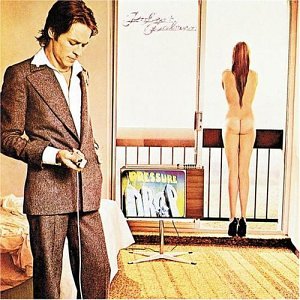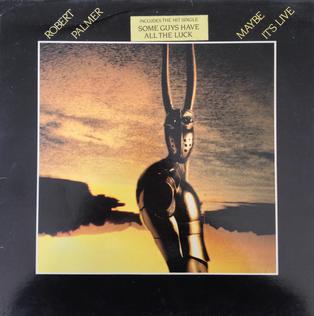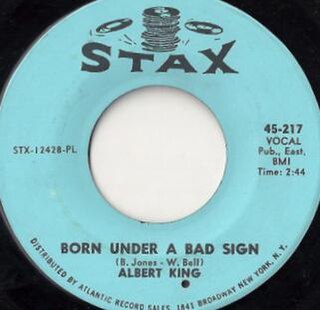
Robert Allen Palmer was an English singer and songwriter. He was known for his powerful, soulful voice and sartorial elegance, and his stylistic explorations, combining soul, funk, jazz, rock, pop, reggae, and blues. Over his four-decade career, Palmer is perhaps best known for the song "Addicted to Love" and its accompanying video, which came to "epitomise the glamour and excesses of the 1980s".

Allen Richard Toussaint was an American musician, songwriter, arranger, and record producer. He was an influential figure in New Orleans rhythm and blues from the 1950s to the end of the century, described as "one of popular music's great backroom figures." Many musicians recorded Toussaint's compositions. He was a producer for hundreds of recordings: the best known are "Right Place, Wrong Time", by longtime friend Dr. John, and "Lady Marmalade" by Labelle.

Lowell Thomas George was an American singer, songwriter, multi-instrumentalist, and record producer, who was the primary guitarist, vocalist, songwriter and founder/leader for the rock band Little Feat.

Little Feat is an American rock band formed by lead vocalist and guitarist Lowell George, keyboardist Bill Payne, drummer Richie Hayward and bassist Roy Estrada in 1969 in Los Angeles. The band's classic line-up, in place by late 1972, comprised George, Payne, Hayward, bassist Kenny Gradney, guitarist and vocalist Paul Barrere and percussionist Sam Clayton. George disbanded the group because of creative differences shortly before his death in 1979. Surviving members re-formed Little Feat in 1987 and the band has remained active to the present.

Sailin' Shoes is the second studio album by the American rock band Little Feat, released in 1972. Produced by Ted Templeman, it marked a shift away from the sound of the band's eponymous debut, to that of their subsequent album, Dixie Chicken. It also introduced the cover artwork of Neon Park to the group, and was the last album appearance of original bassist Roy Estrada.

Dixie Chicken is the third studio album by the American rock band Little Feat, released in 1973. The artwork for the front cover was by illustrator Neon Park and is a reference to a line from the album's third song, "Roll Um Easy".

Rejuvenation is the fifth studio album by the New Orleans funk group The Meters. It was released in 1974. In 2003, the album was ranked number 138 on Rolling Stone magazine's list of the 500 greatest albums of all time, and 139 in a 2012 revised list.
Funk rock is a fusion genre that mixes elements of funk and rock. James Brown and others declared that Little Richard and his mid-1950s road band, the Upsetters, were the first to put the funk in the rock and roll beat, with a biographer stating that their music "spark[ed] the musical transition from fifties rock and roll to sixties funk".

Live Phish 04.02.98 is a live album by American rock group Phish, which was recorded live at the Nassau Coliseum in Uniondale, New York, on April 2, 1998, which serves as the first night of the band's four-night "Island Tour",

Joseph "Ziggy" Modeliste, also known as Zigaboo Modeliste, is an American drummer best known as a founding member of the funk band the Meters. He is widely considered an innovator in the funk genre and New Orleans style drumming. The Meters' music had a defining role and set the stylistic tone of New Orleans funk. Due to his work with the band, Modeliste is credited as an integral part of bringing New Orleans second-line grooves into popular music.

Pressure Drop is the second solo album by English singer Robert Palmer, released in 1975. Palmer is backed by Little Feat and other musicians. The title track is a cover version of the reggae hit by Toots & the Maytals. However, many other songs on the album use "New Orleans funk ... along with smooth, dated disco ballads smothered in strings". Continuing his association with Little Feat started by his cover of "Sailing Shoes" on his 1974 debut album Sneaking Sally Through the Alley, Feat was used as backing band on several cuts, most notably Lowell George's slide guitar on "Here With You Tonight". George also contributed the tune "Trouble" on which Feat pianist Bill Payne plays the intro. David Jeffries' review says that the album is considered "too blue-eyed and polished for fans of Palmer's more gutsy moments" but concludes that "Pressure Drop has grown into the great overlooked album in Palmer's discography". In June 2009, the album was ranked as No. 20 on Mojo's list of the 50 best records released by Island. The album peaked at No. 136 in the US.

Maybe It's Live is a live album by Robert Palmer, released in 1982. It combines six live tracks of old songs with four new songs recorded in the studio, including "Some Guys Have All the Luck", which was a hit for Palmer in the UK, peaking at No. 16 on the UK Singles Chart.

Cabbage Alley is the fourth studio album by the funk group the Meters, produced by Allen Toussaint and Marshall Sehorn and released in May 1972 by Reprise Records. It was the band's first album for the label, following the demise of Josie Records a year earlier, and the signing afforded the group a higher recording budget and re-introduced organist and keyboardist Art Neville to the lineup, having briefly left the band some time earlier.
Jody Linscott is an American session musician and percussionist who resides in England and maintains an extended discography. She has two daughters Kachina Dechert and Coco Linscott and has written two children's books which were published by Doubleday, both edited by Jackie Onassis. Linscott has written several songs to accompany the books.

George Porter Jr. is an American musician, best known as the bassist and singer of the Meters. Along with Art Neville, Porter formed the group in the mid 1960s and came to be recognized as one of the progenitors of funk. The Meters disbanded in 1977, but reformed in 1989. The original group played the occasional reunion, with the Funky Meters, of which Porter and Neville are members, keeping the spirit alive, until Neville's retirement in 2018 and death the following year.

Leo Nocentelli is an American musician and songwriter best known as a founding member and lead guitarist of the funk band the Meters. He wrote the original versions of several funk classics such as "Cissy Strut" and "Hey Pocky A-Way". As a session musician he has recorded with a variety of notable artists such as Dr. John, Robert Palmer and Etta James. He is the recipient of a Grammy Lifetime Achievement Award as a member of the Meters.

"Born Under a Bad Sign" is a blues song recorded by American blues singer and guitarist Albert King in 1967. Called "a timeless staple of the blues", the song also had strong crossover appeal to the rock audience with its synchronous bass and guitar lines and topical astrology reference. "Born Under a Bad Sign" appeared on the R&B chart and became a blues standard.

Addictions: Volume 2 is the second compilation album by English singer Robert Palmer, released in 1992. The album contained noted songs that Robert Palmer had from his Island Records albums Riptide, Sneakin' Sally Through the Alley, Pressure Drop, Double Fun, Secrets, Clues and Pride. This compilation has most of its songs being either remixed, remade, revoiced, or with early fades, with the exception of songs 10 and 14.

Together is the second studio album by the American R&B vocal group Sister Sledge, released on August 9, 1977, by Cotillion Records. The album was the group's first release on the Cotillion label after parting from Atco Records.

This is the discography for American R&B-jazz musician Allen Toussaint.


















